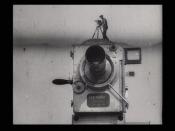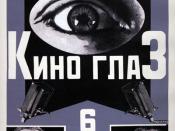Documentaries are a form of movie media known as a nonnarrative formal system. Breaking the system down into smaller categories, four groups emerge (categorical, associational, rhetorical, and abstract). Focusing on the associational and rhetorical style will help to analyze the documentaries Man with a Movie Camera (Dziga Vertov), Roger and Me (Michael Moore), The Thin Blue Line (Errol Morris) and Black Is Black Ain't (Marlon Riggs).
The associational formal system lends itself to the Soviet montage school of editing. Instead of using a 'straightforward' image to convey a topic this system is more about juxtaposing various images that may not directly communicate the director's vision. This forces the viewer to become more intellectual during the viewing of the movie. The director's ideas and images don't always build up to one central point, instead using smaller repetitious parallel relationships to allow the viewer to connect themes by building associational links.
The silent film A Man With a Movie Camera (Dziga Vertov) is such an example of an associational documentary. This self-reflexive film using life in the Soviet Union is all about the power of filmmaking. This film becomes a celebration of the documentary filmmaker's power to control our perception of reality by means of editing and special effects (Bordwell 416). Using various images that may not be normally grouped together Vertov hoped to show how everyday actions could be applied to filmmaking. For example: One brief segment shows the camera lens focusing and then a blurry shot of flowers coming into sharp focus. This is followed immediately by a camera juxtaposition rapidly intercutting two elements: a women's fluttering eyelids as she dries her face off with a towel, and a set of venetian blinds opening and closing. Finally another shot shows the camera lens with...
![[Roger Bresnahan, St. Louis, NL (baseball)] (LOC)](https://s.writework.com/uploads/7/79036/roger-bresnahan-st-louis-nl-baseball-loc-thumb.jpg)

